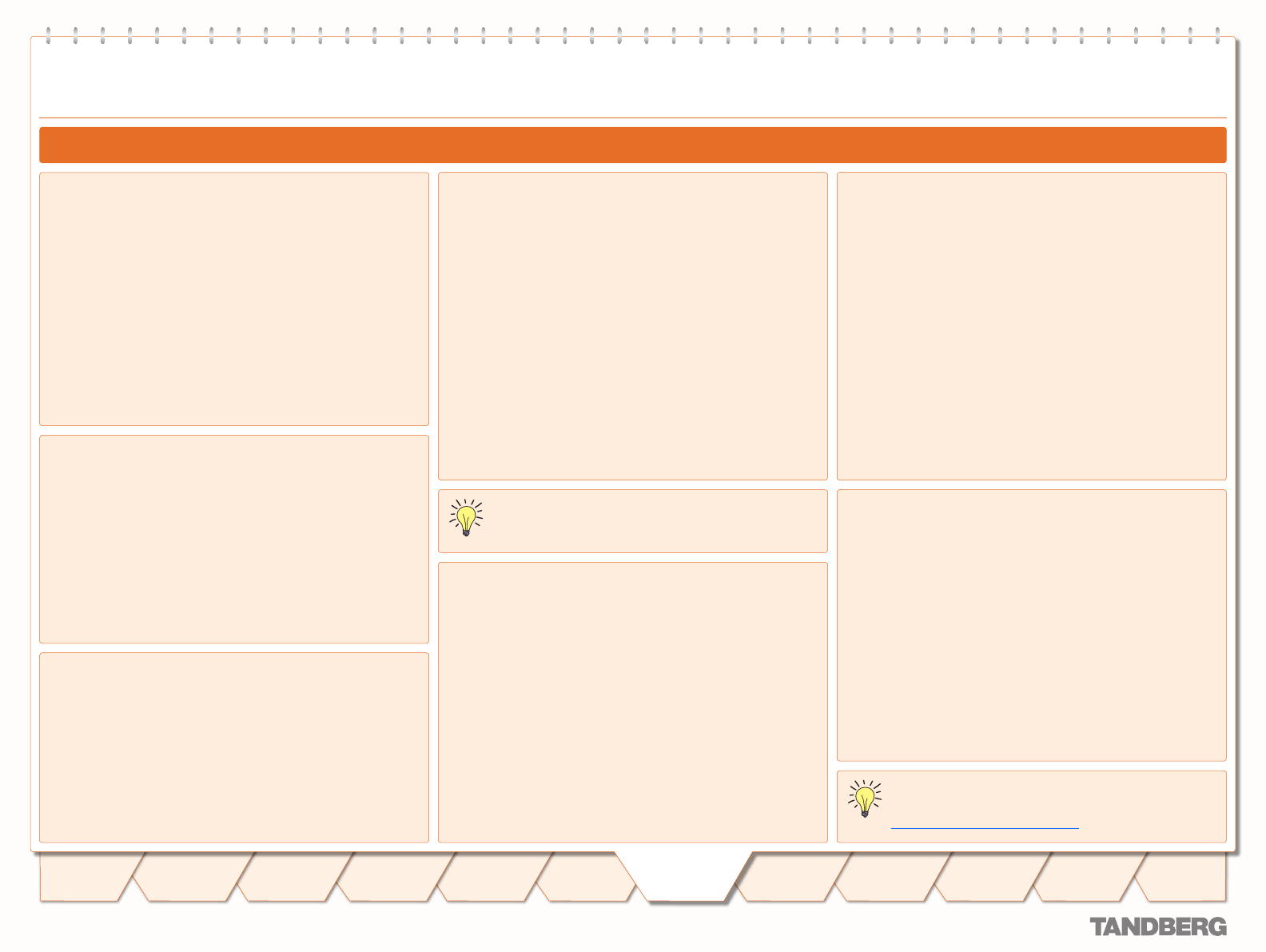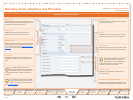
D 14049.01
07.2007
51
D 14049.01
07.2007
51
Introduction
Getting
Started
System
Overview
System
Configuration
H.323 & SIP
Configuration
Registration
Control
Zones and
Neighbors
Call
Processing
Firewall
Traversal
Bandwidth
Control
Maintenance
Appendices
Zones and
Neighbors
Managing Zones, Neighbors and Alternates
DNS Zone
DNS zones allow you to locate endpoints via a DNS lookup.
You can create one or more DNS zones based on pattern
matching of the endpoints’ aliases.
Once you have configured one or more DNS zones, you can:
apply transforms to alias search requests directed to that
group of endpoints
control the bandwidth used for calls between your local VCS
and each group of DNS endpoints.
•
•
About Zones
A zone is a collection of endpoints, either all registered to a
single system (e.g. VCS, gatekeeper or Border Controller), or
of a certain type such as ENUM or DNS. The use of zones
enables you to:
use links to determine whether calls can be made between
your local subzones and these other zones
manage the bandwidth of calls between your local subzones
and endpoints in other zones
more easily search for aliases that are not registered locally
apply transforms to aliases before searching for them.
Your VCS allows you to configure up to 200 zones of 5 different
types. It also has a non-configurable Default Zone.
•
•
•
•
Zones
Default Zone
Any incoming calls from endpoints that are not recognized as
belonging to any of the existing configured zones are deemed to
be coming from the Default Zone.
The VCS comes pre-configured with the Default Zone and
default links between it and both the Default Subzone and the
Traversal Subzone.
The purpose of the Default Zone is to allow you to manage
incoming calls from unrecognized endpoints to the VCS. You
can do this by:
deleting the default links. This will prevent any incoming
calls from unrecognized endpoints
applying pipes to the default links. This will allow you to
control the bandwidth consumed by incoming calls from
unrecognized endpoints.
•
•
Neighbor Zone
A Neighbor zone could be a collection of endpoints registered
to another system (e.g. VCS, gatekeeper, or Border Controller),
or it could be a SIP device. The other system is referred to
as a neighbor. Neighbors can be part of your own enterprise
network, part of a separate network, or even stand-alone
systems.
You create a neighbor relationship with the other system by
adding it as a neighbor zone on your local VCS. Once you have
added it, you can:
query the neighbor about its endpoints
apply transforms to any queries before they are sent to the
neighbor
control the bandwidth used for calls between your local VCS
and the neighbor zone.
•
•
•
Traversal Client Zone
In order to be able to traverse a firewall, the VCS must be
neighbored with a traversal server (for example a TANDBERG
Border Controller or another VCS with the Border Controller
option enabled).
In this situation your local VCS is a traversal client, so you
neighbor with the traversal server by creating a traversal client
zone on your local VCS. You then configure it with details of the
corresponding zone on the traversal server.
Once you have neighbored with the traversal server you can:
use the neighbor as a traversal server
query the traversal server about its endpoints
apply transforms to any queries before they are sent to the
traversal server
control the bandwidth used for calls between your local VCS
and the traversal server.
•
•
•
•
Traversal Server Zone
The VCS may be enabled to act as a traversal server by
installing the Border Controller option (contact your TANDBERG
representative for further information).
In order to act as a traversal server, the local VCS must be
neighbored with each system (e.g. VCS or gatekeeper) that will
be its traversal client. To do this, you create a traversal server
zone on your local VCS and configure it with the details of the
corresponding zone on the traversal client.
Once you have neighbored with the traversal client you can:
provide firewall traversal services to the traversal client
query the traversal client about its endpoints
apply transforms to any queries before they are sent to the
traversal client
control the bandwidth used for calls between your local VCS
and the traversal client.
•
•
•
•
ENUM Zone
ENUM zones allow you to locate endpoints via an ENUM lookup.
You can create one or more ENUM zones based on the ENUM
DNS suffix used and/or by pattern matching of the endpoints’
aliases.
Once you have configured one or more ENUM zones, you can:
apply transforms to alias search requests directed to that
group of endpoints
control the bandwidth used for calls between your local VCS
and each group of ENUM endpoints.
•
•
The default links can be reinstated at any time via the
command:
xCommand DefaultLinksAdd
In order for firewall traversal to work, the traversal
server and the traversal client must each be configured
with the other’s details.
TANDBERG VIDEO COMMUNICATION SERVER
ADMINISTRATOR GUIDE


















